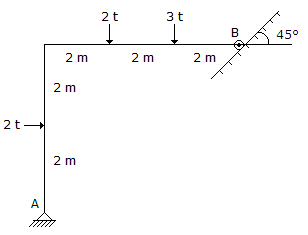Civil Engineering :: Applied Mechanics
-
If three rigid rods are hinged together to form a triangle and are given rotary as well as translatory motion, the number of instantaneous centres of the triangle, will be
-
The mechanical advantage of an ideal machine is 100. For moving the local through 2 m, the effort moves through
-
When a body in equilibrium undergoes an infinitely small displacement, work imagined to be done, is known as
-
The resultant of two forces P and Q acting at an angle θ, is
-
To attain the synchronous orbit, the launch of a satellite, is done from a place
-
The vertical reaction at the support A of the structure shown in below figure, is

-
Pick up the correct statement from the following :
-
If the radius of the earth is 600 km the height of a mountain above sea level at the top of which a beat seconds pendulum at sea level, looses 27 seconds a day, is
-
The total time of collision and restitution of two bodies, is called


 Whatsapp
Whatsapp
 Facebook
Facebook

